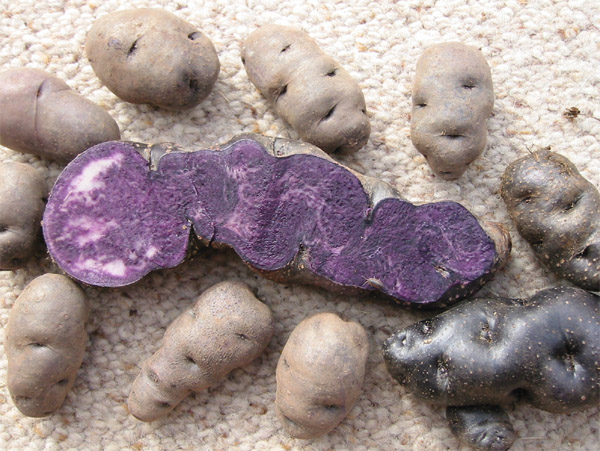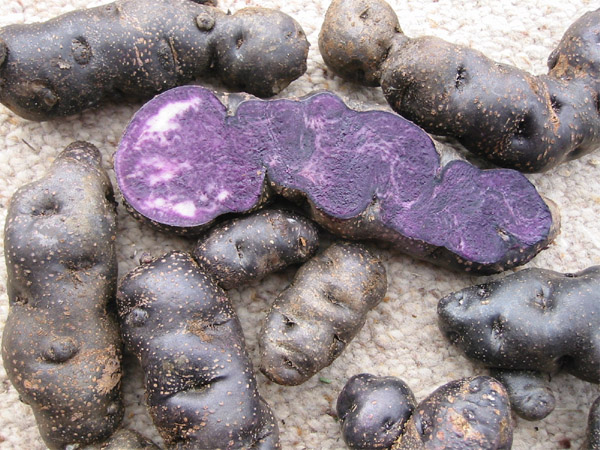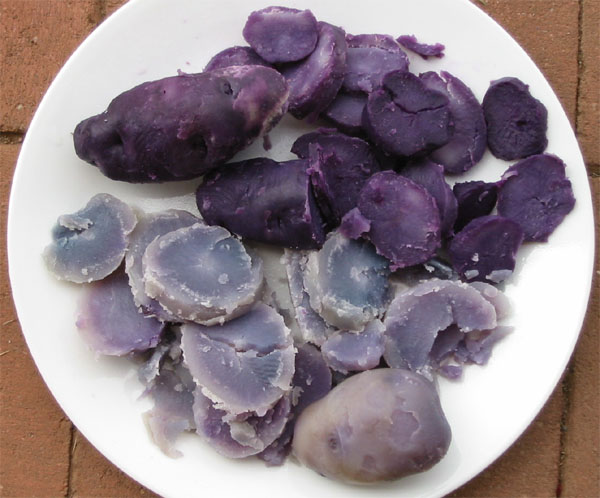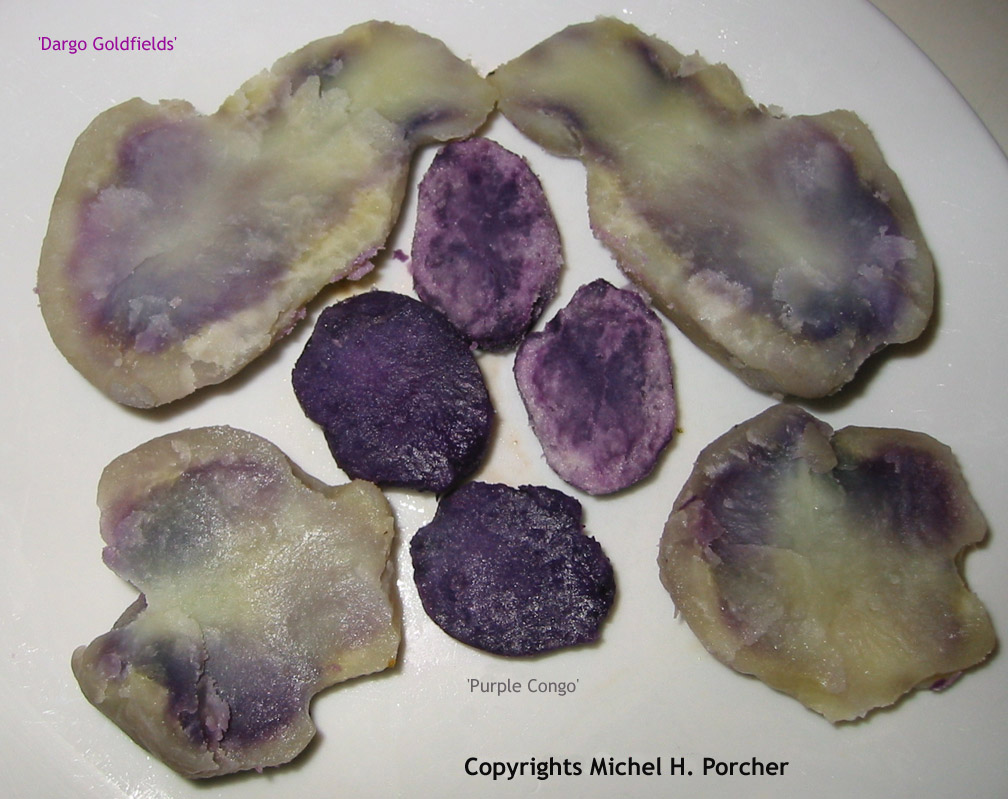Disclaimer - The information in this article is offered in good faith, without warranty. Although the compiling has been done with due care it is not possible to warranty the accuracy of all the data. It is meant to be used with a fair degree of common sense and logic. Neither the author Michel H. Porcher, nor any publisher of this article will have any liability whatsoever to any person or organisation in respect to any alleged loss, damage or liability incurred from the use of the information presented.
Opinions expressed on this page are the author's own and do not represent the views of the Institute of Land & Food Resources, The University of Melbourne or their respective staff.
INTRODUCTION
Since the 1950's I had read in such manuals as the Vilmorin
Catalogues, Le Potager d'un Curieux, Prof. D. Bois Encycopédie
Biologique etc. much praises about the "Vitelotte". It was only in the
1980's that I discovered by accident a "new" variety called "Purple
Congo" in Australia. I have now grown it, processed it, nursed it,
observed it, eaten it in any imaginable way for 2 decades. Having come
across some new scientific material about these kinds of potatoes I
thought it was about time I return to pen and paper for the cause of
the humble purple potato.
A few comments on the "Vitelotte', which may be a synonym of
'Purple
Congo, may be relevant here. "Vitelotte" is the only name listed
in the official European Cultivated Potato Database today. In the
past I have read about
a black, a red and a purple vitelotte. Today Serge Jodra
mentions a few
more that excite my interest : " la Vitelotte jaune imbriquée; la
Vitelotte jaune de Pigry; la Vitelotte rouge longue de l'lndre ou de
Paris; la Vitelotte longue d'Islande, etc." How good would it be to see
photos of these ?
GENERAL DESCRIPTION
The French description : " les Vitelottes ou Cylindriques
: tubercules violets; allongés,
cylindriques, yeux très nombreux et très apparents, et profondément
enchâssés".
Cylindrical, elongated shape with many deep eyes. Certainly the
following photos match. So far so good.


'Purple Congo' - In this shot the "seed potatoes" have been replaced with tubers of a fully mature plant. The tubers are larger and perfectly edible but not suitable for replanting because symptoms of diseases are apparent on the skin and often the inside of those tubers will reveal signs of damage by insects' larvae. The flesh surrounding those "tunnels" exudes a very unpleasant smell and of course tastes awful.
'Purple Congo' (Australia). This is one of the most interesting potatoes from the culinary, horticultural, and medicinal point of views. Unfortunately it is neglected by professionals. Consequently it is mostly left to gardeners and enthusiasts (like myself) to maintain and document it. This has led to a great confusion in the cultivar name(s). Is there more than one cultivar ? or are they all derived from the original "Vitelotte" mentioned in the Vilmorin catalogues of the early 1900's (all names above and below being synonyms) ?
|
|
|
| 'All blue' from Seed Savers Exchange. < http://www.seedsavers.org/prodinfo.asp?number=846(OG) > |
'Purple Peruvian' from Seed Savers Exchange < http://www.seedsavers.org/prodinfo.asp?number=1366(OG) >. |
In their descriptions the Seed Savers
highlight the thin white layer of flesh under the skin of
'All Blue'. They also indicate that 'Purple Peruvian' provide the
deepest purple colour.
Some authors (for example Chef James connected with Purcell
Mountain Farms) have mentioned that the eyes of 'All Blue' are
rather shallow and the above photo seems to display this as well as a
distinctly blue skin, as opposed to the dark-purple / black skin
of
'Vitelotte'. Who would be better placed than a chef to notice how
deep the eyes of a potato tuber are. This suggests that 'All Blue' is a
rather improved cultivar as opposed to the rougher looking, closer to
the wild relatives of the Andean region, 'Vitelotte' (See our gallery).
Well just when I thought I had it all worked out comes out of the blue (no pun intended) some new info that throws my theory out. 'Purple Peruvian' sold by Milk Ranch Specialty Potatoes is purple in and out but has a white flower. Hum! Back to the drawing board...or ... is it ? Flower colour ? good question.
H. De Jong and A. M. Murphy
(Agriculture and Agri-Food Canada Potato Research Centre), in their
article (both English and French versions make interesting
reading) "Congo: A
Versatile Blue-Fleshed Heritage Potato Variety with Many Names"
mention that (partly based on DNA) a group of purple skinned has
been identified (the Congo Group) which includes Congo, British
Columbia Blue, MacIntosh Black, Nova Scotia Blue, River John Blue and
Sharon’s Blue. To these could be added All Blue, Blue Congo, Congo
Blue, Purple Congo, and Himalayan Black. These have
purple fleshed varieties. A subgroup within this Congo Group has white
flesh (Purple Chief and Ruby Pulsiver’s Bluenoser). A small
appendix notes that Vitelotte cannot be incorporated into the Congo
Group. I would suggest that Purple Congo looks too much like Vitelotte
and therefore should not be included either into the Congo Group.
Perhaps that
Purple Peruvian also could be close to Vitelotte and outside the above
group.
This brings us to a possibility that the Vitelotte violette is an
improved
cultivar of the Vitelotte Noire (aka Vitelotte aka Négresse) and is
therefore closer to All Blue than to the primitive Vitelotte of the
Vilmorin catalogues. I rather think however than Vitelotte is the lazy
appellation for either Vitelotte violette or Vitelotte noire as indeed
this potato can appear purple, dark-purple or black depending on
circumstances and / or whether one refers to the flesh or the skin.
These considerations are mostly relevant to taxonomists,
botanists and growers. From the culinary perspective however most
blue or purple fleshed potatoes will show off their outstanding
colour in similar fashion (see 2 photos below for the possible range). Based on experience in the field
and in the kitchen rather than on DNA
I am putting forward the possible following division. The middle column
is basically the Congo Group of De Jong & Murphy minus 2 "black"
cultivars and 'Purple Congo', the right hand column is also the
subgroup mentioned by these two authors. A few more likely synonyms as
well as other foreign names have been added in each of the 3 groups.
| Purple
/ dark-purple flesh + dark-purple / black skin |
Purple flesh + blue / purple skin | White
flesh + blue / purple skin |
| 'Négresse' aka 'Vitelotte Violette' aka 'Vitelotte' aka 'Vitelotte Noire' aka 'Blaue Trüffel' | 'All Blue' aka 'Blue Marker' aka 'Purple Marker' aka 'Blaue Hindelbank' aka 'Färberkartoffel' | 'Peruanische Blaue mit Gelben Augen' |
| 'Purple Congo' aka 'Peruanische Blaue' aka 'Purple Peruvian' aka 'Peruvian Purple' aka 'Blå Kongo' | 'British Columbia Blue' | 'Purple Chief' |
| 'Himalayan Black' | 'Congo' aka 'Blue Congo' aka 'Congo Blue' | 'Ruby Pulsiver’s Bluenoser' aka
'White Congo' |
| 'Lehmanns Unbekannte' | 'Nova Scotia Blue' | |
| 'MacIntosh Black' | 'River John Blue' | |
| 'Sapphire' | ||
| 'Sharon’s Blue' | ||
| 'Blauschalige Norddeutsche' |
In
order to dress a more accurate table, one would need far more
information than anyone seems to have on hand
(or is willing to divulge). For each cultivar photos of flower,
new shoot, tuber, flesh would be a start. Then further data
such as origin, days from planting to maturity, average yield,
resistance to diseases / pests, uses in the kitchen etc. would complete
the emerging picture.
Culinary
displays
All of these "purple potatoes" once
cooked and broken in a particular way can
display an inside resembling a beautiful blue-coloured gem (having
handled some of those in my brief "geological" carrier I am always
reminded of those stunning rocks).

'Purple Congo' on top, 'Sapphire' (an
improved cultivar with shallow eyes) on bottom

'Dargo
Goldfields' an old cultivar gone wild in the Australian bush displaying
the same beauty than precious polished rocks when sliced, crystals when
broken-up (not succeeded yet in capturing this on film). See larger photo for a better appreciation.
A small note for the
benefit of French readers.
En
ce qui concerne la culture, une bonne terre fertile produira des
tubercules énormes.
Il est prudent de ne pas attendre la fin de la
plante cependant si on veut la propager car les maladies sévissent
durant les dernières
semaines. Récolter
avant maturité
fournira des
"patates" assez grosses et de bon goût. Cette varietée est très
tardive. En climat temperé
(sud est de l'Australie) je laisse mes
'Vitelottes' / 'Purple Congo' (les noms abondent et les synonyms ne
sont pas enregistrés
proprement) se propager elles mêmes dans certaines parcelles et j'en
prélève selon la technique acceptée. Résultat je n'ai jamais eu besoin
d'acheter un tubercule en 25 ans. A vous de tirer les conclusions.
J'imagine que les organisations biologiques en France peuvent
approvisionner en vitelotte. Victor Renaud et d'autres enthousiastes
aussi seront ravis d'en procurer.
Value
of purple-fleshed potatoes, today and yesterday
To the native people of the Andean regions potato
with coloured flesh had a special place. In addition to their use as
food, potatoes with pigmented flesh were a source of dye and used in
religious ceremonies. Today in health-aware societies, in terms
of nutrition, such potatoes should be regarded as highly as blueberries
or purple carrots or watermelons especially the purple-fleshed potato
due to its high level in anthocyanin pigments which have
"possible health benefits as dietary antioxidants" say the most prudent
doctors. "There is considerable anecdotal and epidemiological
evidence that dietary anthocyanin pigments may have preventive and
therapeutic roles in a number of human diseases" say others more
adventurous.
Coming back to our starting point growers have observed through the
decennies that the 'Vitelotte' and the 'Purple Congo' (perhaps the same
cultivar) have a higher resistance to degeneration than most modern
potato cultivars so even if it had no other value - which is not the
case of course, it would be of some considerable potential to breeders.
Can you spot the ancestors of the Purple Congo in this gallery from the
Centro
Internacional de la Papa - PERÚ
? One species looking like our beloved potato is Solanum
ajanhuiri Juz. et Bukasov and it bears white flowers...
but this is a very superficial dig (both linked images are from the
Botanical and
Experimental Garden of Radboud University, Nijmegen, The
Netherlands).
Date created: 20 / 07 / 2000
Authorised by Prof. Snow Barlow
Last modified: 25 / 10 / 2006
Access: No restriction
Copyright © 1995 - 2020, The University of Melbourne.
Maintained by: Michel H. Porcher,
Disclaimer